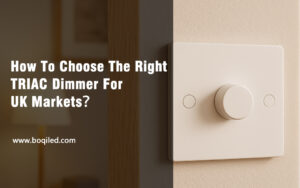L'illuminazione a LED ha trasformato l'illuminazione moderna grazie alla sua efficienza, longevità e luminosità. Ma, come ogni tecnologia, non è esente da problemi. Dallo sfarfallio e dal ronzio alle incongruenze cromatiche, le luci a LED presentano sfide uniche. Ecco una guida per identificare e risolvere i 25 problemi più comuni dell'illuminazione a LED.
L'illuminazione a LED, pur essendo efficiente dal punto di vista energetico e durevole, presenta una serie di problemi unici, come lo sfarfallio, il ronzio, il surriscaldamento e le incongruenze cromatiche. Una corretta installazione e componenti di qualità possono prevenire molti di questi problemi.
I LED sono un'opzione eccellente, ma non sono perfetti. Vediamo i problemi più comuni e come risolverli.
1. Quali sono i problemi più comuni dell'illuminazione a LED?
Le luci a LED presentano comunemente problemi quali sfarfallio, surriscaldamento, ronzii e colori non corretti. Questi problemi spesso derivano da una cattiva installazione, da dimmer incompatibili o da componenti di bassa qualità. L'identificazione tempestiva di questi problemi può aiutarvi ad avere un'illuminazione senza problemi.
2. Perché le luci a LED sfarfallano e come si può risolvere il problema?
Lo sfarfallio è un problema comune dell'illuminazione a LED, spesso causato da interruttori dimmer incompatibili, collegamenti allentati o fluttuazioni di potenza. Fissare: Utilizzare dimmer compatibili, controllare tutti i collegamenti e garantire una fonte di alimentazione stabile per eliminare lo sfarfallio.
3. Cosa fare se le luci LED si surriscaldano?
Il surriscaldamento riduce la durata dei LED e può persino causare problemi di sicurezza. Ciò accade spesso quando i dissipatori di calore sono assenti o la ventilazione del LED è inadeguata. Fissare: Utilizzare sempre LED con dissipatori di calore, garantire una ventilazione adeguata e selezionare il giusto wattaggio per evitare il surriscaldamento.
4. Come risolvere i ronzii nelle luci LED?
I ronzii nei LED sono spesso dovuti a incompatibilità con i dimmer, alla qualità degli apparecchi o a problemi elettrici. Fissare: Utilizzare LED di alta qualità, dimmer compatibilie controllare il cablaggio per eliminare il ronzio.
5. L'illuminazione a LED presenta problemi di salute?
Sì, le emissioni di luce blu dei LED possono influire sul sonno e sulla salute degli occhi, soprattutto in caso di esposizione prolungata. Fissare: Utilizzare LED con una minore emissione di luce blu o passare a LED bianchi caldi per gli spazi in cui si trascorre molto tempo.
6. Perché la mia luce LED non è abbastanza luminosa?
Se la luce dei LED non è luminosa, il problema potrebbe essere dovuto a cali di tensione, LED di scarsa qualità o problemi di circuito. Fissare: Assicurarsi che i circuiti forniscano la tensione necessaria e utilizzare LED di alta qualità per ottenere la massima luminosità.
7. Come evitare l'incoerenza del colore nelle luci LED?
L'incoerenza del colore è spesso causata da variazioni nella qualità di produzione o da problemi di cablaggio. Fissare: Scegliete i LED di marche rinomate e assicurate una qualità di cablaggio costante in tutta l'installazione.
8. Perché le luci LED si accendono e si spengono a intermittenza?
Questo comportamento di "accensione e spegnimento" può indicare problemi di alimentazione, surriscaldamento o un circuito instabile. Fissare: Verificare la presenza di sovraccarichi nel circuito e assicurarsi che il LED abbia una fonte di alimentazione costante per evitare questo problema.
9. Quali sono gli effetti del LED ghosting e come si può evitare?
Il ghosting si verifica quando i LED emettono un debole bagliore anche quando sono spenti. Ciò può accadere a causa dell'elettricità residua nel circuito. Fissare: Per ridurre al minimo questo effetto, utilizzare LED con una maggiore sensibilità alla corrente o installare dispositivi anti-ghosting.
10. Come si risolvono i problemi delle luci LED che non si accendono?
Quando un LED non si accende, controllare l'alimentazione, ispezionare il cablaggio e verificare che il LED stesso non sia difettoso. Fissare: La ricerca guasti di base può rivelare se il problema riguarda la lampadina, il cablaggio o la fonte di alimentazione.
11. Qual è il principale svantaggio dell'illuminazione a LED?
I LED possono produrre una luce blu eccessiva, che influisce sul sonno e provoca abbagliamento. Inoltre, i LED di bassa qualità hanno una durata di vita più breve e possono guastarsi prematuramente. Fissare: Scegliere LED con livelli di luce blu inferiori e investire in prodotti di qualità per una maggiore durata.
12. Come riparare le strisce LED che non funzionano completamente?
Le strisce LED potrebbero non funzionare correttamente a causa di sezioni danneggiate, collegamenti errati o alimentazioni inadeguate. Fissare: Controllare che non vi siano segmenti danneggiati, fissare tutti i collegamenti e assicurarsi che la striscia riceva un'alimentazione sufficiente.
13. Perché i LED a volte causano interferenze con l'elettronica?
I LED, soprattutto quelli di qualità inferiore, possono interferire con il Wi-Fi e altri segnali. Fissare: Cercare i LED con l'etichetta "EMI-free" o utilizzare LED di qualità superiore con riduzione integrata delle interferenze.
14. Perché le luci a LED si guastano prematuramente?
I guasti prematuri sono spesso dovuti a componenti di scarsa qualità, a sbalzi di tensione o a un'installazione non corretta. Fissare: Acquistate da produttori affidabili, proteggete i vostri circuiti dalle sovratensioni e assicuratevi che l'installazione sia corretta.
15. Come evitare che le luci LED si brucino troppo rapidamente?
La bruciatura dei LED può essere causata da surriscaldamento, costruzione di scarsa qualità o alimentazione instabile. Fissare: Utilizzare LED con caratteristiche di dissipazione del calore, mantenere un'alimentazione stabile e acquistare prodotti di qualità.
16. Perché i LED sono incompatibili con alcuni apparecchi?
Gli apparecchi più vecchi potrebbero non supportare le lampadine LED a causa dei loro requisiti di potenza inferiori. Fissare: Per evitare problemi di compatibilità, utilizzare apparecchi progettati specificamente per i LED.
17. Quali sono le cause dei problemi degli interruttori dimmer a LED?
I LED potrebbero sfarfallare o non dimmerarsi correttamente con interruttori dimmer non compatibili. Fissare: Verificare sempre la compatibilità quando si abbinano i LED agli interruttori dimmer. Imparate da questo articolo, Imparare tutto sul dimmer a triac per LED.
18. Come si risolvono i LED che emettono troppi bagliori?
Un'eccessiva luminosità può risultare fastidiosa, soprattutto in spazi ridotti. Fissare: Scegliere LED con diffusori o installare dimmer per ridurre l'abbagliamento.
19. Come gestire le luci LED che interferiscono con le foto o i video?
Lo sfarfallio o le variazioni di luminosità possono causare interferenze LED nel video. Fissare: Per la registrazione dei video, utilizzare driver LED di alta qualità con tecnologia antisfarfallio, I driver LED dimmerabili di boqi sono tutti privi di sfarfallio.
20. Perché alcuni LED appaiono troppo freddi o troppo caldi?
Le incongruenze della temperatura di colore derivano da lotti di LED non corrispondenti. Fissare: Scegliere i LED dallo stesso lotto e testare la coerenza dei colori prima dell'installazione.
21. Come impedire alle luci LED di creare ombre?
I LED posizionati in modo errato possono causare un'illuminazione non uniforme e ombre. Fissare: Disporre con cura i LED e utilizzare i diffusori per un'illuminazione più omogenea.
22. Perché i LED hanno un avvio ritardato?
I LED possono ritardare l'accensione a causa di componenti di scarsa qualità o di problemi di circuito. Fissare: Optate per marchi affidabili con tecnologia ad avvio rapido.
23. Come risolvere il problema della sensibilità alla tensione dei LED?
I LED possono sfarfallare se sono troppo sensibili a piccole variazioni di tensione. Fissare: Utilizzare driver e fonti di alimentazione corretti e stabili. È possibile consultare l'articolo, 10 passi per la scelta del driver LED ideale.
24. I LED sono sicuri da usare in spazi chiusi?
Gli spazi chiusi possono intrappolare il calore e ridurre la durata dei LED. Fissare: Utilizzare LED adatti ad apparecchi chiusi o garantire una ventilazione adeguata.
25. Come far durare di più l'illuminazione a LED?
Per massimizzare la durata di vita dei LED, evitare il surriscaldamento, utilizzare un'alimentazione stabile e scegliere prodotti di alta qualità, come i driver LED e le lampade con un dissipatore di calore più grande. Una corretta installazione e una regolare manutenzione aiutano i LED a durare più a lungo.
L'illuminazione a LED è generalmente un'ottima scelta, ma questi problemi comuni possono comprometterne i vantaggi. Seguendo questi passaggi per la risoluzione dei problemi, potrete assicurarvi che le vostre luci LED rimangano luminose, efficienti e durature.







